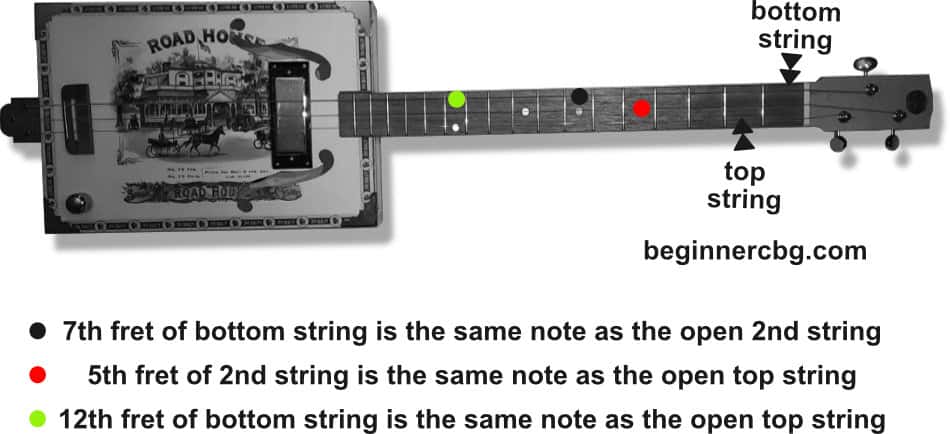Before you play anything on your Cigar Box Guitar, you need to get it in tune, but In some ways it doesn’t matter what you tune it to as long as it is tuned to itself. Although G D G is a common tuning, other tunings are available. In this article I will explain how to:
- tune the guitar to itself
- use a piano
- use a clip-on tuner
- use an app or pitch pipes
Tuning The Cigar Box Guitar To Itself
We usually tune the cigar box guitar in a certain way so that when we strum the open strings we play a power chord. Then with 1 finger, we can play lots of other power chords really easily.
If you just want to tune the guitar to itself, turn the tuning peg or machine head of the bottom string until it sounds how you want it.
Then press that string down on the 7th fret and make the middle string the same as that note.
Then press the middle string down on the 5th fret and tune the top string to that note.

Tuning The Cigar Box Guitar To The Most Common Tuning G D G
If you want to follow along with any YouTube lessons or chord charts, then tuning to G D G is the most common tuning.
Using A Piano Or Keyboard
To do this, either use something that you know the notes on e.g. a piano or keyboard and tune your strings like this:
Bottom thickest string to G2
Middle string to D3
Top thinnest string to G3
Or you can tune the bottom thickest string to G2 and then use the 7th and 5th fret tricks from the first paragraph.
(If you aren’t sure what G2 means, you need to start at the lowest note of the piano and find the second G up from that )
Using A Clip-On Tuner
You can use a clip on Snark tuner, available on Amazon.com here : Snark clip-on electronic tuner
I really love mine as it’s so easy to tell when the string is in tune as long as you are in the right octave, so basically if you are not too far out of tune. The problem with these as a beginner is that it’s difficult to get the correct octave if you’re not used to knowing what the sound is like.
If you are re-stringing your guitar, I find it easier to replace one string at a time and getting it roughly in tune before moving onto the next. This really helps with not being an octave out. If you are too high, you risk breaking the string and if you are too low, the note will sound ” flabby”.
I’ve recorded a 20 second video of the 3 notes if you are struggling to find the right octave:
Using A Guitar App Or Pitch Pipe
Or use a guitar app or blow pipe and tune the top thinnest string to the G string ( 3rd string) of a six string guitar.
Then tune the middle string to the D string ( 4th string) of a six string guitar
Tune the bottom thickest string an octave lower than the top string. You can check this by pressing that thickest string on the 12th fret and it should be the same note as the top string.
Where To Go From Here
Now your guitar is in tune, read more on this website and try some beginner-friendly lessons:
